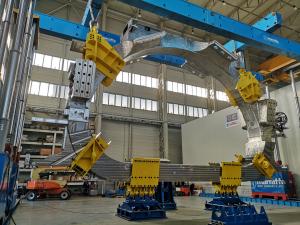Fusion for Energy has worked closely with European industry at every stage of the process: Luvata (copper strand); Oxford Instruments Superconducting Technology and Bruker European Advanced Superconductors (niobium-tin strand); the ICAS consortium (ENEA, Tratos and Criotec) for conductor cabling, jacketing and spooling; CNIM and SIMIC for radial plate manufacturing; the ASG consortium (ASG Superconductors, Iberdrola Ingeneria, Elytt Energy) for the creation of the superconducting winding pack; and finally SIMIC and subcontractor Babcock Noell for the final production steps (including cold testing, insertion of the winding pack into a structural steel case, and closure welding and machining).
In all, 700 people from at least 40 companies took part.
Eighteen "D"-shaped toroidal field magnets placed around the ITER vacuum vessel will produce a magnetic field whose primary function is to confine the plasma particles. The toroidal field coils are designed to produce a maximum magnetic field of 11.8 tesla and store 41 gigajoules of energy. Weighing over 300 tonnes and measuring 9 x 17 m, they are among the largest components of the ITER machine. The European Domestic Agency is responsible for the procurement of ten toroidal field coils; the Japanese Domestic Agency is producing eight complete coils plus one spare, as well as all structural steel cases. (ITER Japan's first coil left Kobe port
last week.)
Once delivered to the project, ITER's construction teams will take over to prepare the magnet coils for assembly. Mechanical preparatory activities include welding cooling pipes and cable trays, attaching clamps to support other coils, and welding interfaces.
See the full story and press releases in English, Spanish or Italian here.




